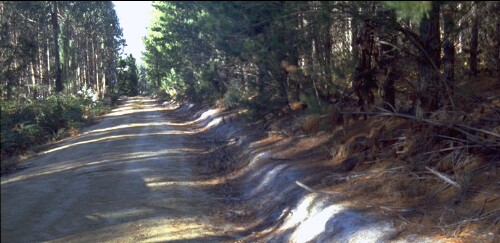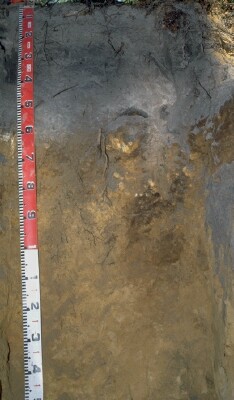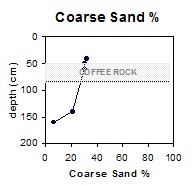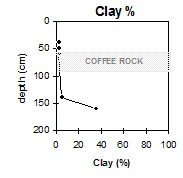CFTT15
| SITE: CFTT 15 | Site: Gormandale |
| Location: APP species/seedlot trial VRV 144 | Aust. Soil Class.: Melacic, Humosesquic, Aeric PODOSOL |
| Great Soil Group: podsol | Tech. Class: 022-2-43/1-2-3-12 |
| General Landscape Description: Dunefield | Site Description: (5 % slope to north) |
| Geology: Late Tertiary sediments | APP Mapping Unit: Flynn |

CFTT15-16 Landscape
Soil Profile Morphology:
Surface Soil
| A1 | 0 – 40 cm | Very dark grey (10YR3/1) loamy sand; single grained; very weak consistence moist; pH 4.6; gradual and smooth transition to: |  CFTT15 Profile |
| A2 | 40 – 60 cm | Dark grey (10YR4/1) loamy sand; single grained; loose dry; pH 5.0; sharp and wavy transition to: | |
| Subsoil | |||
| Bhs | 60 – 90 cm | Dark brown (7.5YR3/4), with medium distinct strong brown (7.5YR5/6) mottles common, sand; single grained; very many ferruginous-organic nodules (less than 60 mm); pH 4.9; clear, wavy and irregular transition to: | |
| C1 | 90 – 140 cm | Brownish yellow (10YR6/6) sand, single grained; pH 5.8; clear and wavy transition to: | |
| C2 | 140 – 160 cm | White (10YR8/1), many, very coarse, prominent yellowish brown (10YR5/8) with red (2.5YR4/8) mottles, fine sandy medium clay; pH 5.6; strong consistence moist. | |
Key Profile Features:
- Deep sandy surface horizons.
- Many ferruginous-organic nodules (‘coffee rock’) in upper subsoil (ie. Bhs horizon)
pH | Salinity Rating | |||
Surface (A1 horizon) | Very strongly acid | Very low | Non-sodic | None |
Subsoil (B21 horizon) | Very strongly acid | Very low | Non-sodic | None |
Deeper subsoil (at 1 m) | Moderately acid | Very low | Non-sodic | - |
 The upper soil profile is very strongly acid; becoming moderately acid at depth. |  The coarse sand content is high throughout most of the soil profile. |  The clay content is low throughout most of the soil profile. |
Horizon | Horizon Depth | pH (water) | pH CaCl2 | EC 1:5 | NaCl | Exchangeable Cations | |||
Ca | Mg | K | Na | ||||||
Meq/100g | |||||||||
A1 | 0-40 | 4.6 | 3.9 | <0.05 | 0.26 | 0.2 | <0.05 | <0.05 | |
A1b | 5 | 4 | <0.05 | 1.2 | 0.37 | <0.05 | 0.1 | ||
A2 | 40-60 | 4.9 | 4.1 | <0.05 | 0.26 | 0.1 | <0.05 | <0.05 | |
C1 | 90-140 | 5.8 | 5 | <0.05 | 0.21 | 0.15 | <0.05 | 0.06 | |
C2 | 140-160 | 5.6 | 4.6 | <0.05 | 0.68 | 2.9 | <0.05 | 0.14 | |
Horizon | Horizon Depth | Ex Al mg/kg | Ex Ac meq/100g | Field pF 2.5 | Wilting Point pF4.2 g/100g | Coarse Sand (0.2-2.0mm) % | Fine Sand (0.02-0.2mm) % | Silt (0.002-0.02mm) % | Clay (<0.002mm) % |
A1 | 0-40 | 40 | 4.1 | 4.2 | 2.1 | 31.8 | 62.1 | 1 | 2 |
A1b | 47 | 8 | 7.2 | 2.8 | 29.8 | 61.6 | 3 | 2.5 | |
A2 | 40-60 | 17 | 2.4 | 4.5 | 1.2 | 29.8 | 61.2 | 2 | 1.5 |
C1 | 90-140 | <10 | 2.7 | 5.2 | 4.3 | 20.6 | 70.6 | 1.5 | 4.5 |
C2 | 140-160 | 38 | 4.9 | 22.4 | 12.7 | 6.4 | 55.3 | 3 | 35.5 |
- Sandy clays continue to 2m depth. This is a shallow version of Flynn Sand soil type.
- Plant Available Water Capacity (PAWC) is low for sandy soils such as these. The soils are, however, well drained.
- These strongly acidic sandy soils have a very low nutrient holding capacity and are considered infertile – being naturally deficient in nitrogen, phosphorus, sulphur and potassium. Nitrate and sulphate are readily removed by leaching. Deficiencies of trace elements such as copper, zinc and molybdenum are likely to occur. The trace element boron (B) leaches rapidly through acid sandy soils and deficiencies are also likely to occur.


